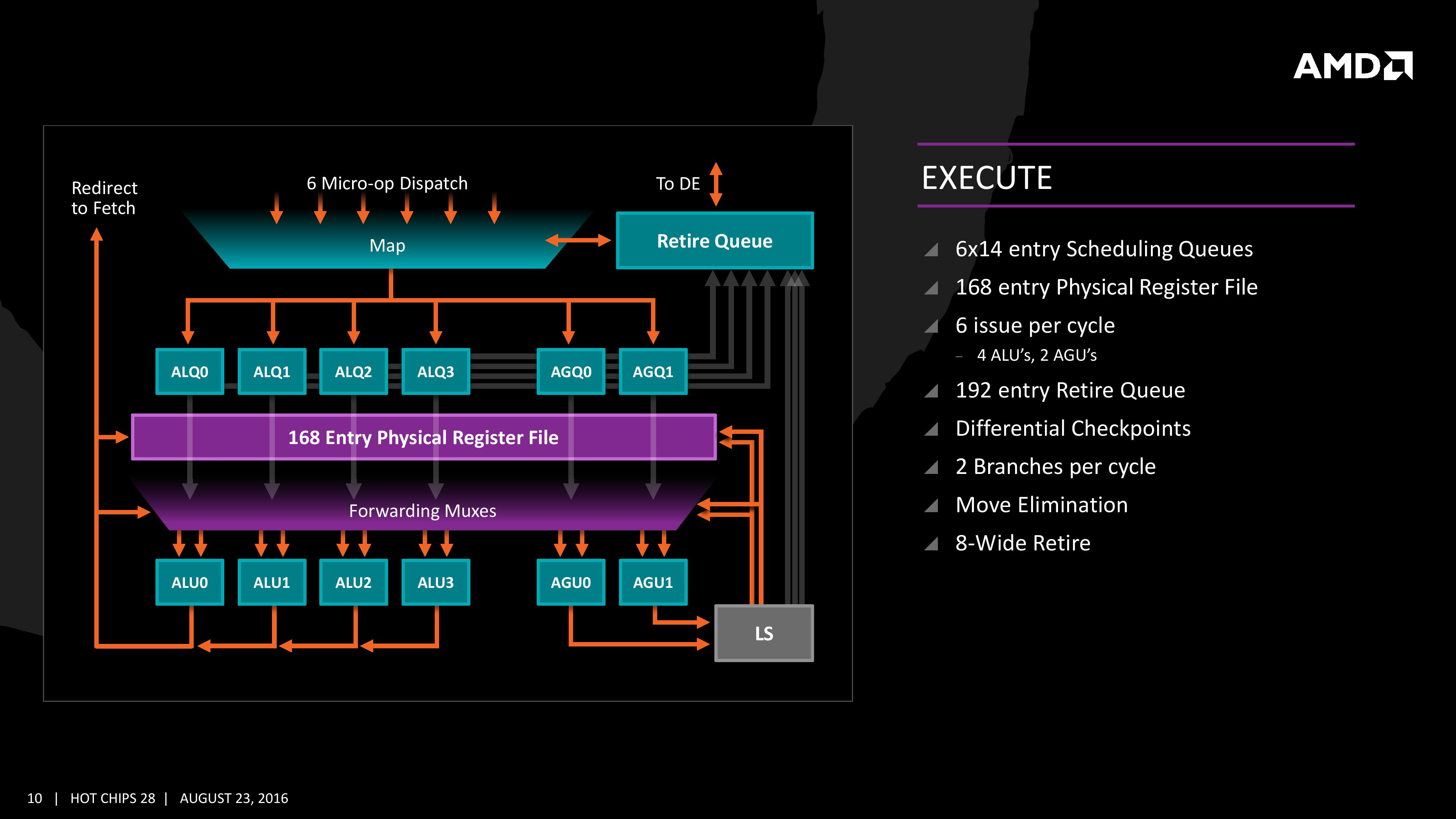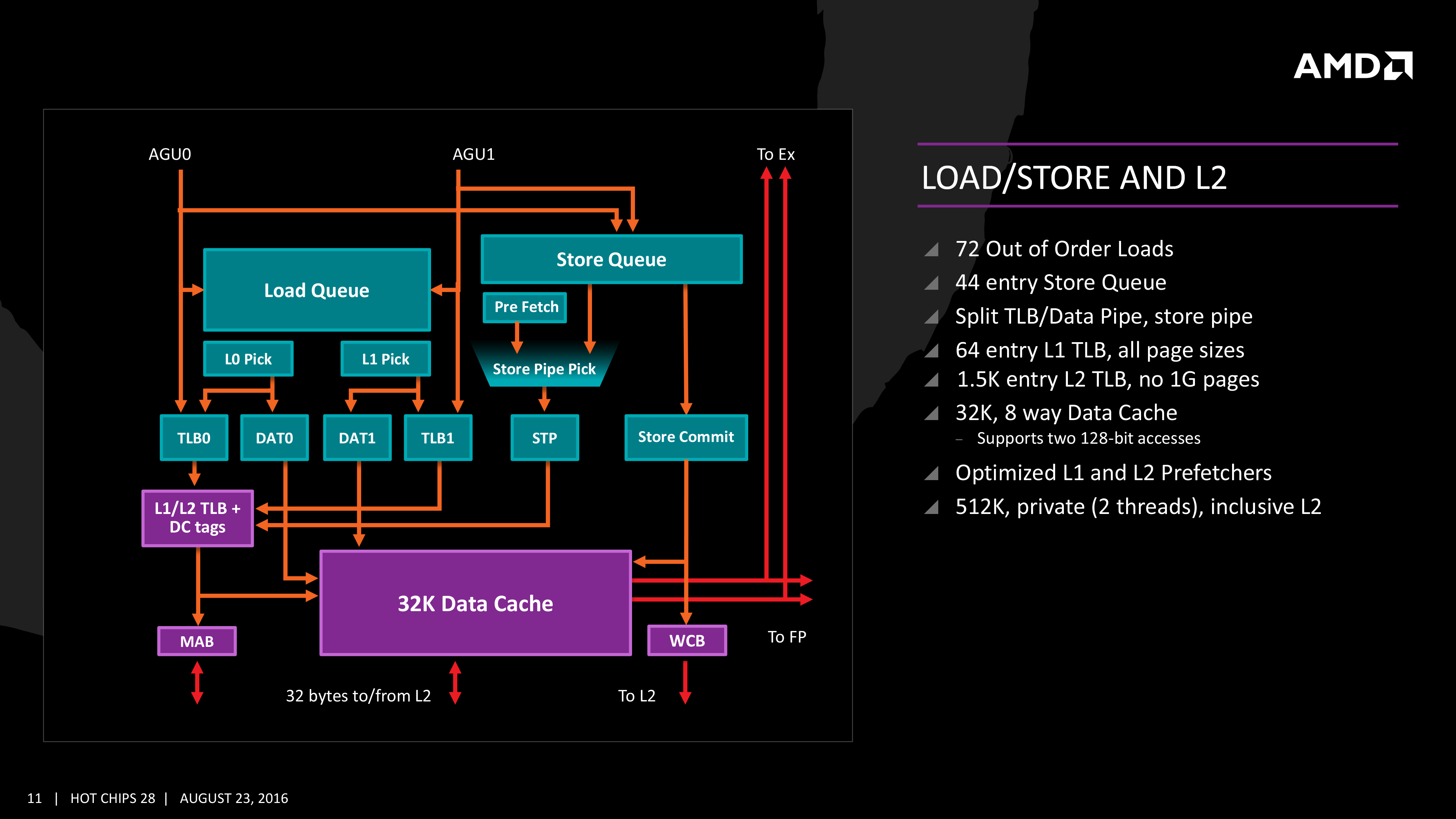AMD Zen Microarchiture Part 2: Extracting Instruction-Level Parallelism
by Ian Cutress on August 23, 2016 8:45 PM EST- Posted in
- CPUs
- AMD
- x86
- Zen
- Microarchitecture
Execution, Load/Store, INT and FP Scheduling
The execution of micro-ops get filters into the Integer (INT) and Floating Point (FP) parts of the core, which each have different pipes and execution ports. First up is the Integer pipe which affords a 168-entry register file which forwards into four arithmetic logic units and two address generation units. This allows the core to schedule six micro-ops/cycle, and each execution port has its own 14-entry schedule queue.
The INT unit can work on two branches per cycle, but it should be noted that not all the ALUs are equal. Only two ALUs are capable of branches, one of the ALUs can perform IMUL operations (signed multiply), and only one can do CRC operations. There are other limitations as well, but broadly we are told that the ALUs are symmetric except for a few focused operations. Exactly what operations will be disclosed closer to the launch date.
The INT pipe will keep track of branching instructions with differential checkpoints, to cut down on storing redundant data between branches (saves queue entries and power), but can also perform Move Elimination. This is where a simple mov command between two registers occurs – instead of inflicting a high energy loop around the core to physically move the single instruction, the core adjusts the pointers to the registers instead and essentially applies a new mapping table, which is a lower power operation.
Both INT and FP units have direct access to the retire queue, which is 192-entry and can retire 8 instructions per cycle. In some previous x86 CPU designs, the retire unit was a limiting factor for extracting peak performance, and so having it retire quicker than dispatch should keep the queue relatively empty and not near the limit.
The Load/Store Units are accessible from both AGUs simultaneously, and will support 72 out-of-order loads. Overall, as mentioned before, the core can perform two 16B loads (2x128-bit) and one 16B store per cycle, with the latter relying on a 44-entry Store queue. The TLB buffer for the L2 cache for already decoded addresses is two level here, with the L1 TLB supporting 64-entry at all page sizes and the L2 TLB going for 1.5K-entry with no 1G pages. The TLB and data pipes are split in this design, which relies on tags to determine if the data is in the cache or to start the data prefetch earlier in the pipeline.
The data cache here also has direct access to the main L2 cache at 32 Bytes/cycle, with the 512 KB 8-way L2 cache being private to the core and inclusive. When data resides back in L1 it can be processed back to either the INT or the FP pipes as required.
Moving onto the floating point part of the core, and the first thing to notice is that there are two scheduling queues here. These are listed as ‘schedulable’ and ‘non-schedulable’ queues with lower power operation when certain micro-ops are in play, but also allows the backup queue to sort out parts of the dispatch in advance via the LDCVT. The register file is 160 entry, with direct FP to INT transfers as required, as well as supporting accelerated recovery on flushes (when data is written to a cache further back in the hierarchy to make room).
The FP Unit uses four pipes rather than three on Excavator, and we are told that the latency in Zen is reduced as well for operations (though more information on this will come at a later date). We have two MUL and two ADD in the FP unit, capable of joining to form two 128-bit FMACs, but not one 256-bit AVX. In order to do AVX, the unit will split the operations accordingly. On the counter side each core will have 2 AES units for cryptography as well as decode support for SSE, AVX1/2, SHA and legacy mmx/x87 compliant code.













106 Comments
View All Comments
CrazyElf - Tuesday, August 23, 2016 - link
If they can really get a 40% improvement over Excavator, and I mean 40% on average, not on a few select benchmarks, then AMD has a serious chance of being a compelling option once again.I'm hoping to see more improvements on Floating Point, which was comically bad in Bulldozer.
A big part of the problem is that we don't know how well Zen will clock or the power consumption. Still, this should be a major leap in performance overall. We'll have to wait for the launch day benchmarks to see the true story.
Another big concern is the platform. CPU performance is only part of the story. We need a good platform that can rival the Z170 and Intel HEDT platforms for this to be compelling on the desktop. For mobile, there will have to be good dual channel Zen APUs (Carrizo, as Anandtech noted was heavily gimped by poor quality OEM designs obsessed with cost cutting).
jabber - Wednesday, August 24, 2016 - link
Yeah I don't think OEMs and others are that worried about supporting AMD. AMD have withered away so much, making AMD CPU capable gear must have become a very minor part of say ASUS/Gigabyte/MSI etc. revenue stream. Making AMD based graphics cards is okay but motherboards? Not so much.teuast - Wednesday, August 24, 2016 - link
I wouldn't speak so soon. Just this year MSI and Gigabyte (at least) have introduced new AM3+ boards with USB 3.1 and PCIe 3.0. Why, I'm not sure, but if they're doing that for something as old and deprecated as the FX chips, it would defy logic for Zen to come out and for them to only release a few token efforts.I will say, if the CPUs are good but you're right about OEMs not being concerned with support, then the first OEM to say "hey, why don't we make some actually good AM4 boards?" is going to make an absolute killing.
h4rm0ny - Thursday, August 25, 2016 - link
Are you sure about the PCI-E v3 on AM3+ motherboards? I can find recent releases that have USB3.1 and M.2, but none that support PCI-Ev3. Can you link me or provide a model number? I didn't think 3rd generation PCI-E was possible on the Bulldozer line.SKD007 - Thursday, August 25, 2016 - link
SABERTOOTH 990FX/GEN3 R2.0SKD007 - Thursday, August 25, 2016 - link
https://www.asus.com/Motherboards/SABERTOOTH_990FX...Outlander_04 - Thursday, August 25, 2016 - link
A little misleading . The Graphics pci-e controller is built in to an FX processor so adding a pci-e 3 standard slot to a motherboard will make no difference to actual bandwidth.Not an issue though since x16 pci-e 2 has the same bandwidth as x8 pci-e 3 and intel boards with SLI/crossfire ability running at x8/x8 do not choke any current graphics card
h4rm0ny - Thursday, August 25, 2016 - link
What about PCI-E SSDs? Can I get full bandwidth on those? I agree about the graphics cards but that's not so important to me. If I can get full PCI-Ev3 x4 performance for an SSD then I'll pribably buy this as a hold-over until Zen. Thanks fir the link!fanofanand - Friday, August 26, 2016 - link
Pci-e 3.0 x4 should be the same as 2.0 x 8. So long as you have a vacant x8 it should theoretically work the same.extide - Wednesday, September 7, 2016 - link
I think they use a PLX chip and turn the 32 2.0 lanes from the FX chip into 16 3.0 lanes.